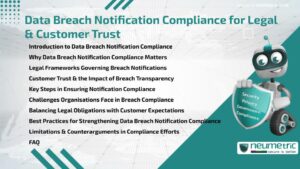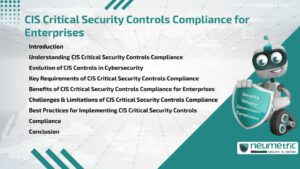Table of Contents
ToggleIntroduction
CIS critical Security Controls Compliance is a widely recognised Framework that helps Enterprises strengthen their Cybersecurity posture. Developed by the Center for Internet Security [CIS], the Framework defines a prioritised set of Best Practices designed to protect Systems, Data & Networks against the most prevalent Cyber Threats. By implementing CIS critical Security Controls Compliance, Enterprises can reduce Vulnerabilities, enhance Resilience & build a stronger Defence Strategy. This article explores its history, requirements, benefits, challenges & best practices for effective adoption.
Understanding CIS Critical Security Controls Compliance
CIS critical Security Controls Compliance provides a structured approach to managing Cybersecurity Risks. The Framework consists of twenty (20) Controls grouped into Basic, Foundational & Organisational categories.
These Controls cover areas such as Asset Management, Vulnerability Management, Access Control & Incident Response. The Framework is flexible & scalable, making it suitable for Enterprises of different Sizes & Industries. More information is available on the CIS official website.
Evolution of CIS Controls in Cybersecurity
The CIS Controls were originally introduced in 2008 as the “Consensus Audit Guidelines.” They were developed to address common attack Vectors & standardise Security Practices. Over time, the Framework has evolved through multiple versions, incorporating input from Cybersecurity Experts, Industry Stakeholders & Government bodies.
The latest version, CIS Controls v8, reflects changes in modern IT environments, such as Cloud adoption, Remote work & Mobile devices. This evolution shows how the Framework adapts to the shifting Threat landscape.
Key Requirements of CIS Critical Security Controls Compliance
Enterprises must address the following areas to achieve CIS critical Security Controls Compliance:
- Asset Inventory: Maintaining an updated inventory of Hardware & Software.
- Access Control: Limiting access based on Roles & Least Privilege Principles.
- Vulnerability Management: Regular Scanning & Patching of Systems.
- Data Protection: Encrypting Sensitive Information & managing Data Retention.
- Incident Response: Establishing tested plans for handling Cyber Incidents.
- Security Awareness: Training Employees to recognise & prevent Cyber Threats.
These requirements are mapped to widely used frameworks such as NIST Cybersecurity Framework, enabling interoperability & alignment.
Benefits of CIS Critical Security Controls Compliance for Enterprises
CIS Compliance provides significant benefits:
- Improved Security Posture by addressing the most common Cyber Threats.
- Operational efficiency through prioritised & standardised practices.
- Regulatory alignment with frameworks such as NIST, ISO & PCI DSS.
- Reputation enhancement by demonstrating strong Cybersecurity practices.
- Cost savings by preventing Breaches & reducing Recovery Expenses.
In short, CIS critical Security Controls Compliance transforms Cybersecurity from a reactive process into a proactive Business strategy.
Challenges & Limitations of CIS Critical Security Controls Compliance
Despite its advantages, implementing the CIS Controls presents some challenges:
- Resource demands: Smaller Enterprises may lack Staff & Budgets.
- Complexity: Implementing twenty (20) Controls across diverse Systems can be overwhelming.
- Ongoing updates: Enterprises must adapt as the Controls evolve.
- Integration hurdles: Aligning CIS Controls with existing frameworks may require significant effort.
These limitations mean that Enterprises need careful Planning & Phased Implementation.
Best Practices for Implementing CIS Critical Security Controls Compliance
To successfully implement CIS critical Security Controls Compliance, Enterprises should:
- Start with a Risk Assessment to identify priority areas.
- Adopt Phased Implementation by focusing on the most critical Controls first.
- Automate Processes like Vulnerability Scanning & Patching.
- Conduct regular Training to build a culture of Security Awareness.
- Leverage External Expertise from certified Auditors or Consultants.
Practical Resources can be accessed from CISA’s Cybersecurity Resources.
Conclusion
CIS critical Security Controls Compliance is a practical, effective & widely adopted Framework for enhancing Cybersecurity. By focusing on prioritised Best Practices, Enterprises can better protect their Systems, reduce Risks & align with Global Standards.
Takeaways
- CIS Compliance offers a prioritised set of twenty (20) Controls.
- The Framework helps Enterprises address evolving Cyber Threats.
- Benefits include improved Security Posture, Efficiency & Regulatory alignment.
- Challenges involve Resource demands, Complexity & Integration.
- Best Practices include phased Implementation, Automation & Staff training.
FAQ
What is CIS critical Security Controls Compliance?
It is a Framework of twenty (20) prioritised practices that Enterprises adopt to strengthen Cybersecurity & reduce Vulnerabilities.
Why are CIS critical Security Controls important for Enterprises?
They are important because they address the most common Cyber Threats & help Enterprises adopt structured, efficient Security Measures.
How are CIS Controls structured?
The Controls are grouped into Basic, Foundational & Organisational categories to help Enterprises prioritise implementation.
Is CIS Compliance mandatory?
No, it is not legally mandatory, but it is widely adopted & often used to demonstrate strong Security Practices.
Can Small Enterprises achieve CIS Compliance?
Yes, Smaller Enterprises can achieve Compliance by focusing on the most critical Controls & implementing Changes in phases.
How do CIS Controls relate to other frameworks?
They align with frameworks like NIST, ISO 27001 & PCI DSS, providing Interoperability & consistency in Compliance efforts.
What are the main challenges of CIS Compliance?
Challenges include high Resource demands, complexity of Implementation & the need to adapt to Updates.
How often should Enterprises review their CIS Compliance?
Regular reviews & Audits should be conducted annually or whenever major changes occur in Systems or Policies.
Need help for Security, Privacy, Governance & VAPT?
Neumetric provides organisations the necessary help to achieve their Cybersecurity, Compliance, Governance, Privacy, Certifications & Pentesting needs.
Organisations & Businesses, specifically those which provide SaaS & AI Solutions in the Fintech, BFSI & other regulated sectors, usually need a Cybersecurity Partner for meeting & maintaining the ongoing Security & Privacy needs & requirements of their Enterprise Clients & Privacy conscious Customers.
SOC 2, ISO 27001, ISO 42001, NIST, HIPAA, HECVAT, EU GDPR are some of the Frameworks that are served by Fusion – a SaaS, multimodular, multitenant, centralised, automated, Cybersecurity & Compliance Management system.
Neumetric also provides Expert Services for technical security which covers VAPT for Web Applications, APIs, iOS & Android Mobile Apps, Security Testing for AWS & other Cloud Environments & Cloud Infrastructure & other similar scopes.
Reach out to us by Email or filling out the Contact Form…





